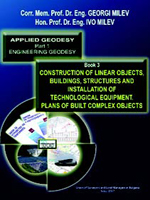ESSENCE, ROLE AND SIGNIFICANCE OF THE SYSTEM OF MONOGRAPHS ON ENGINEERING GEODESY
APPLIED GEODESY - PART 1. ENGINEERING GEODESY - Summary
The project "APPLIED GEODESY" of the authors G. Milev and I. Milev consists of three parts:
- Engineering surveying
- Application of Geodesy in Earth Sciences
- Non-engineering and natural scientific aspects of application of Geodesy
The three parts together treat the versatile application of Geodesy.
Part 1. ENGINEERING SURVEYING consists of three books:
- Basics, systems and technologies in Engineering Surveying – 498 p.
- Design and implementation of physical and general plans – 325 p.
- Construction of linear objects, buildings, facilities, installation of technological equipment. Plans of the built complex objects – due to the large volume, over 1500 pages, it is separated into three books - 3(3.1 – 524 p.), 3(3.2 – 530 p.) и 3(3.3 – 468 p.)
Books 3 of Part 1, Engineering Surveying of Applied Geodesy, consider the nature, tasks and role of Engineering Surveying in the design, tracing, construction and operation of specific types of engineering objects – linear objects, buildings, facilities and installation of technological equipment, plans, models and information systems of built complex sites, etc.
Due to the versatility of the problems treated and the large volume of the matter discussed, exceeding 1500 computer pages, Book 3 is issued as three books – 3(3.1), 3(3.2) and 3(3.3).
Book 3(3.1) presents the design, construction, operation and reconstruction of linear objects and the specificities of geodetic works for railways, roads, objects of electric supply, communications, water supply and sewerage, cable-ways as well as tunnels and metro lines.
Book 3(3.2) includes the problems related to the design, construction and installation of facilities along other linear objects, e.g. bridges, as well as geodetic methods and technologies for tracing, control measurements and studies of their deformations. The same problems are also considered for hydrotechnical objects, built independently or in complexes of engineering ones – dams, cascades, etc., as well as hydro melioration objects, river corrections, floods and droughts and ports.
Book 3(3.3) presents the research, design, tracing and control and deformation studies during the construction, assembly and operation of buildings, industrial facilities and technological equipment, installation of machines for various purposes, as well as civil objects – airports, sport, high-rise objects, etc. Further on the composition of plans and modeling is shown for the built objects – BIM (Building Information Models) and the cadastre of communications of complexes of engineering objects and relevant information systems, respectively – Specialized Data (model) of underground communications, as well as other engineering aspects of application.
The exposition in 3(3.1), 3(3.2) and 3(3.3) provides first brief specific information about the essence, construction, requirements, regulatory base and features of the various objects. So, among other things, up-to-date engineering information and terminology are used and experts speak the same language, even more so that the problems addressed are interdisciplinary ones.
The book is with an original structure. The exposition is in conformity with the accepted way of presentation in Books 1 and 2 of the authors, with the current regulatory framework and the possibilities afforded by modern digital devices, instruments, systems and technologies. It reflects to a significant extent the views, years of research, teaching experience, involvement in the construction and study of deformations of engineering objects, including such with original spatial design solutions, implemented with the participation of the authors.
Books 3(3.1), 3(3.2) and 3(3.3) are intended for specialists working on construction (research, design, construction, installation) and operation of various engineering objects and complexes of them, as well as for lecturers, PhD students, students in the area of Architecture, Civil Engineering and Geodesy, etc., and for practitioners in the field of construction and engineering surveying, recommendably with books 1 and 2.
In digital form, parts of the first three books (including in English) are available in the electronic bookstore biblio.bg (password Георги Милев or tinyurl.com/2p9jyydn).
Such information, and for the last two books 3.2 and 3.3, will be uploaded there soon.
